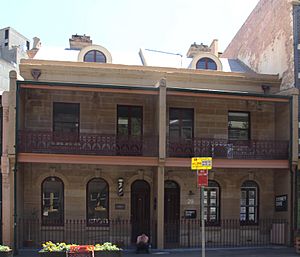29-31 George Street, The Rocks facts for kids
Quick facts for kids 29-31 George Street, The Rocks |
|
|---|---|

Pictured in 2019
|
|
| Location | 29-31 George Street, The Rocks, City of Sydney, New South Wales, Australia |
| Built | 1866 |
| Owner | Property NSW |
| Official name: Terraces; 29-31 George Street, The Rocks | |
| Type | State heritage (built) |
| Designated | 10 May 2002 |
| Reference no. | 1608 |
| Type | Terrace |
| Category | Residential buildings (private) |
| Lua error in Module:Location_map at line 420: attempt to index field 'wikibase' (a nil value). | |
The buildings at 29-31 George Street are two historic homes in The Rocks, a famous area in Sydney, Australia. These buildings were once terrace houses, which are like townhouses, and now they are used as offices. They were built a long time ago in 1866.
These buildings are very important because they are listed on the New South Wales State Heritage Register. This means they are protected because of their history and special design. The property is currently owned by Property NSW, which is a part of the Government of New South Wales.
Contents
A Look Back at History
This land, located between Gloucester and George Streets, has a rich history. In October 1834, it was officially given to a man named Robert Campbell Snr. He had been using the land since about 1805.
Later, in 1848, Robert Campbell's sons and son-in-law were allowed to sell parts of his land that the family no longer needed. In 1851, a part of the land was sold to William Reilly for £120.
Reilly decided to build on this land in 1866. He constructed two houses, each about 9 meters wide. In 1867, these new houses were described as having two floors plus an attic. They had strong stone walls, possibly made from stone dug up right there, and roofs covered with wooden shingles.
From 1867 to 1873, different people rented Reilly's houses. These included accountants, religious leaders, and other professionals. Because the houses were on the higher side of north George Street, the people living there had amazing views of the harbour. This was before big warehouses were built closer to the water.
In July 1873, Reilly sold the land and houses to Thomas Wilton Eady, who was a leather merchant, for £1,400. It seems Eady also built a large shed behind the houses. From 1874 to 1887, Eady lived at 29 George Street and ran his leather business from there. During the same time, James McCarthy, a warehouse worker and shoemaker, lived at No. 31.
After 1888, Eady's houses were used as boarding houses, where people could rent rooms. By 1890, the roofs were changed to corrugated iron. In 1900, a law called the Observatory Hill Resumption Act was passed. This meant the government could buy land for public use. In 1903, Eady's family sold the two houses to the government for £2,500.
Much later, in 1978-79, the Sydney Cove Redevelopment Authority (SCRA) worked to restore and fix up the buildings. This cost about $56,000.
What the Buildings Look Like
These buildings are designed in an Early Victorian style. They have two main floors plus an attic. The front of the buildings is made of stone, which gives them a strong and classic look. The roof is covered with asbestos cement shingles. Inside, the floors are made of timber.
How They've Changed
In 1978-79, the buildings at 29-31 George Street went through a big restoration. This work cost $56,000.
Outside, some parts were removed, like the old bathroom and laundry areas. Fences that divided the courtyards and one on the side of No. 31 were also taken down. Some old plaster was removed from a nearby hotel wall. Electrical boxes, gas meters, and TV antennas were also removed. New stones were added to the front of the buildings, and the brickwork was fixed. The chimney at the back (for the kitchen) was taken apart and rebuilt to look like the original. All the wooden parts of the roof were checked and replaced if they were rotten. The roof covering was also replaced.
Inside, old pipes and wires were removed. All light fittings, blinds, curtains, and even small nails were taken off the walls, ceilings, and floors. Some inner walls were removed to make it easier to move between rooms.
Why They Are Heritage Listed
The two houses at 29-31 George Street are very special. They are a great example of Victorian terrace houses. These types of homes were common for wealthy merchants living in The Rocks in the mid-1800s. Their simple but beautiful stone work makes them stand out. They add to the unique look of north George Street and the historic feel of The Rocks area. The buildings and their location are important to the history of New South Wales.
These houses were added to the New South Wales State Heritage Register on May 10, 2002, because they meet certain important standards:
- They show how history unfolded in New South Wales.
These large, beautiful houses are linked to the merchant class who lived in The Rocks in the middle of the 19th century. People living here once had amazing views of the harbour before other buildings blocked them.
- They show great design and skill.
The houses at 29-31 George Street are a wonderful example of Victorian terrace housing. Their simple, well-finished stone work and careful details make them special. They help make north George Street look diverse and add to the historic feel of The Rocks.
- They have a special connection to the community.
These houses are important because they add to the unique look of north George Street and the historic character of The Rocks.

